Preston Corporation Tramways
History
Preston Corporation became a tramway owner during the first week of September 1882, when it opened two, 3ft 6in-gauge horse tramway lines, one from the Town Hall northwestwards to Ashton-on-Ribble, and the other from the bottom of Fishergate Hill eastwards through the centre of town to the Pleasure Gardens in New Hall Lane, in total 5.5 miles. The corporation was not however legally able to work the tramway itself, so operation was leased to a local horse omnibus firm, W Harding & Co Ltd.
The corporation's new lines were in fact not the first trams in Preston, that accolade going to the Preston Tramways Company, which had been operating a 2.5-mile horse line since the 20th March 1879. The company line ran from the Town Hall northwards along Lancaster Rd, then eastwards along Victoria Rd to Fulwood Barracks; it was also built to a gauge of 3ft 6ins, primarily due to the narrowness of the central thoroughfares in the town.
The corporation was however not content to share the town with a private tramway operator, but was instead keen to have all the town's tramways under municipal control. A price was subsequently agreed with the PTCo for its tramway assets, the company running its last tram on the 31st December 1886, and Hardings taking over next day (as the corporation's lessee). As far as is known, during the period between the opening of the corporation's lines and the corporation takeover (April 1882 to January 1887), the corporation and the company lines were worked completely independently of each other, and may not even have been connected.
Hardings worked the corporation horse tramway throughout its entire life, which at its maximum totalled around 8 miles. The corporation eventually decided that conversion to overhead electric traction was called for, and in 1900, and again 1902, it sought and obtained powers to build and operate a new electric tramway system, converting the horse lines from 3ft 6ins to standard gauge in the process. Rather than a gradual changeover, the corporation chose to close the horse tramway at the end of Harding's lease, the last Preston horse tram running on the 31st December 1903.
The first corporation electric service commenced on the 7th June 1904 along the former horse tramway route to Fulwood, with other lines following on fairly quickly, the system essentially assuming its final form on the 26th January 1905, with the opening of the Ribbleton route. Although extensions were repeatedly discussed, and the corporation was relatively forward looking in terms of technology (e.g., automatic point changers and trolley reversers) and tramcars, none were ever built, with the tramway ultimately failing to serve large areas of Preston's population.
The corporation in fact seems to have made a habit of deferring decisions or taking them and then doing nothing about them, a practice which saw them endlessly put off extensions, only for the Great War to put paid to them when at last they finally chose to proceed. This pattern was repeated after the war, with the corporation obtaining permission for track alterations but then not carrying them out, and even acquiring powers to convert the entire tramway system to trolleybus operation, which it then made no use of.
The system was however very profitable, regularly paying substantial sums to the relief of rates, with plenty left over for renewals, which the Tramways Department seems to have always been on top of. The Great War of course led to a drop-off in maintenance and an inability to purchase track, spares or new tramcars, but the system seems to have emerged from it in better shape than many other concerns. After the end of the conflict, and despite increased operating costs and inflationary pressures, the corporation found the money to continuing investing in the system, replacing track, buying secondhand cars and completely rebuilding others.
The corporation also dipped its toes into bus operation, the first services commencing on the 23rd January 1922. Further bus routes were introduced in 1924, one of which — to Ashton Lane Ends — resulting in the closure of the terminal end of the Ashton tram line, which looped back to Ashton from Tulketh Rd, a service which was then no longer needed. Although new bus services continued to be introduced during the 1920s, investment in the tramway nevertheless continued up to around 1929, when the corporation suddenly developed an interest in trolleybuses. Whilst nothing was to come of this, after the corporation had expended time and energy in acquiring the necessary powers, a metaphorical line had been crossed in terms of tramway abandonment, and the anti-tram faction on the council was now to have the upper hand.
In order to reflect the increasing reliance on buses, the name of the department was changed in the summer of 1931 — to Preston Corporation Transport — and early the following year (on the 18th January 1932) the decision was taken to convert the Farringdon Rd and Penwortham lines to petrol-bus operation, both lines being in need of expensive track renewal. Buses took over on these routes on the 4th July 1932, though it is believed that some trams continued to run for a short while afterwards, probably when there weren't enough buses to cover the services. The Ashton and Ribbleton lines went in 1933, leaving only the circular, which lasted until 1935, the last tram of all running on the 15th December that year.
At its maximum, Preston's tramway system extended to 10.53 miles, comprising lines from the centre of town (Church St): northeastwards to Ribbleton; eastwards to Farringdon Park; westwards to the bottom of Fishergate then southwards to Penwortham Bridge; northwestwards to Ashton; and a loop line northwards to Withy Trees, then eastwards to Fulwood, then southwards along Deep Dale Rd to join the Ribbleton Route and thence back to Church St. The tramway remained isolated all its life, so was never connected to another tramway system.
Uniforms
Preston Corporation was a horse tramway owner from 1882 when it opened its first line, through to closure of the horse system on the last day of 1903; however, for this entire period, the corporation chose to lease operation of the services to a private company — W Harding and Co Ltd — rather than working the system itself. Although numerous photographs of horse-tram crews have survived, these are predominantly from the last seven or so years of operation, so what follows below is based largely upon that evidence; however, given that these photographs clearly show that horsecar crews did not wear uniforms, there is currently no reason to think that this was any different in earlier years (1880s and early 1890s). Both drivers and conductors wore smart but informal attire, namely: jackets, trousers, shirts and ties, along with the fashionable headgear of the day, predominantly the bowler hat, but also the flat cap. The latter was presumably a development of the mid-to-late 1890s, when these came into vogue. Drivers sometimes also wore leather aprons. No insignia of any kind appears to have been worn, including municipal licence badges.
Early photographs indicate that uniforms had not been delivered (or ordered) in time for the inaugural services, so crewmen simply wore informal but smart attire, invariably topped off with a flat cap. However, relatively soon after services began, uniforms were introduced; these consisted of double-breasted lancer-style tunics with five pairs of buttons (narrowing from top to bottom, and presumably in brass — see link), epaulettes and stand-up collars. The collars carried an employee number (in individual numerals) on both sides, presumably in brass to match the buttons, whereas the epaulettes bore system initials, 'P C T' in individual letters, though they may have initially been plain, i.e., without badges. The tensioned-crown peaked caps bore script-lettering grade badges (again presumably brass), either 'Driver' or 'Conductor'. The style of uniform does not appear to have changed at all over the entire 30-year history of the electric system.
Given that the name of the undertaking was changed in 1931, it is highly likely that issues of new uniforms after this date would have borne 'Preston Corporation Transport' insignia.
Tramcar staff were also issued with long, double-breasted greatcoats with five pairs of buttons and high, fold-over collars; the latter carried employee numbers on both sides, again presumably in brass.
Inspectors were probably issued with single-breasted jackets with hidden buttons (or more likely a hook and eye affair) and stand-up collars, with the jacket and pockets edged in a finer material then the main body. The tensioned-crown peaked caps carried the bearer's grade — 'Inspector' — on a hat band, in embroidered script lettering.
In common with the vast majority of UK tramway systems, Preston employed women during the Great War, as conductresses (from 21st May 1915 onwards), to replace male staff lost to the armed services. Female staff were issued with single-breasted, tailored jackets with four pockets (with button closures), epaulettes and stand-up collars, along with long matching skirts; the collars carried an employee number on both sides. Headwear was similar to the men's caps, but with a noticeably wider tensioned crown; they carried the same script-lettering grade badges that were used on the men's caps.
Further reading
For a history of Preston's tramways, see: 'The Tramways of Preston' by G W Heywood, in the Tramway Review, Nos 67 (p67-77/92), 68 (p99-124), 69 (p131-146), 70 (p163-167/181-191), 71 (p207-212) and 77 (p154-160); Light Railway Transport League (1971, 1972, and 1974).
Images
Horse tram drivers and conductors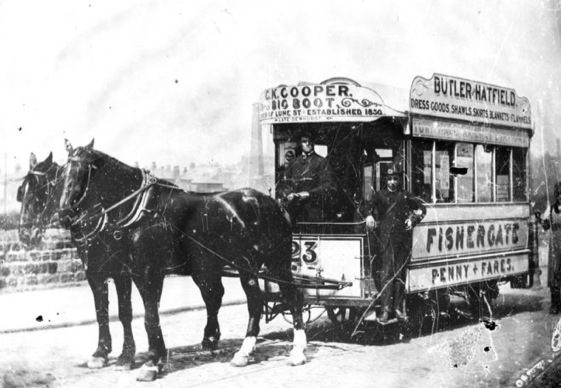
A single-deck horse car (No 23) and crew in Fishergate, Preston — photo undated, but given the style of dress and the elaborate vehicle livery, almost certainly taken in the early years of corporation ownership, i.e., the 1880s. Both men appear to be wearing informal but smart attire. Photo courtesy of the Tramways and Light Railway Society, with thanks to David Voice.
Horsecar No 27 stands in Newton Road Ashton — photo undated, but from the style of the bowler hats (with upturned brims), possibly taken in the early-to-mid 1890s. Photo courtesy of Barbara Quinn via the Preston Digital Archive (see link).
An enlargement of the above photograph showing the crew, both of whom are wearing bowler hats typical for the early 1890s. Both men are wearing informal attire with no evidence if badges or licences.
A horsecar driver and conductor pose for the camera outside the Excelsior Art Studio on the Lancaster Road to Fulwood Barracks route — photo undated, but given the conductor's flat cap, probably taken in the mid-to-late 1890s. Photo courtesy of the Tramways and Light Railway Society, with thanks to David Voice.
An enlargement of the above photograph showing the driver, in a long coachman's coat, and the conductor in an informal jacket; the former is wearing a bowler hat and the latter, a flat cap.
A driver and a conductor at Cemetery Gates — photo undated, but probably turn of the century. Photo courtesy of Preston Digital Archive (see link).
A driver and his helper (possibly a stable lad or trace-horse boy), change their horse around at the bottom of Fishergate, possibly in 1903. The driver is wearing a leather apron. Photo courtesy of Preston Digital Archive (see link).
A horse tram driver and his conductor with an unidentified horse car near Fulwood Barracks in late 1903. Photo courtesy of the National Tramway Museum. 
An enlargement of the above photograph showing the driver. The poster on the tram advertises the coming sale of 80 horses on January 5th, presumably 1904 given that W A Harding & Co's lease was terminated on the last day of 1903.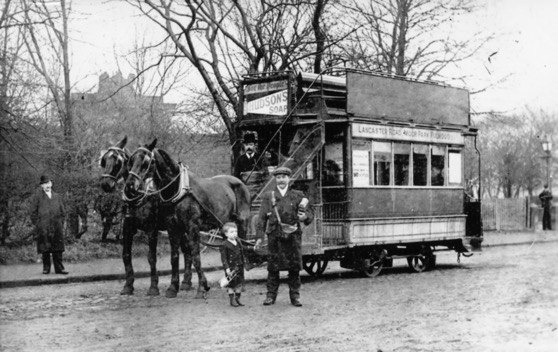
A rather charming photo of a Preston horse tram driver, conductor and a young boy, possibly the conductor's son — taken near Fulwood Barracks in late 1903. Photo courtesy of the Tramways and Light Railway Society, with thanks to David Voice.
An enlargement of the above photograph showing the driver (with blanket and bowler hat) and the conductor (in smart informal jacket and a flat cap).
A driver and a conductor with their rather battered-looking charge at the bottom of Fishergate Hill — photo purportedly taken on the last day of operation, 31st December 1903. Photo courtesy of Preston Digital Archive (see link).

Preston licence badge — brass. There is no photographic evidence to support this type of licence ever being issued to horsecar drivers, so in all likelihood, it was for private hire and/or horse bus drivers. With thanks to Chris Gardiner.
Motormen and conductors
Two conductors and a motorman with what would appear to be a brand new Tramcar No 6 on a service for Fulwood Barracks — photo undated, but almost certainly taken in June 1904 when this route opened. Photo copyright of the Harris Museum and Art Gallery, Preston; courtesy of the Harris Museum and Art Gallery, Preston (see link).
An enlargement of the above photograph showing the two conductors, both of whom are wearing informal attire.
Another blow-up of the above photograph showing the motorman. His overcoat collars bear some form of initials, whilst his soft-topped cap appears to be devoid of insignia.
Tramcar No 6 again, clearly in pristine condition, and in revenue-earning service — photo undated, but almost certainly taken in 1904. Richard Rosa Collection.
An enlargement of the above photograph showing the crew, both of whom are wearing informal attire, inclusive of cloth caps.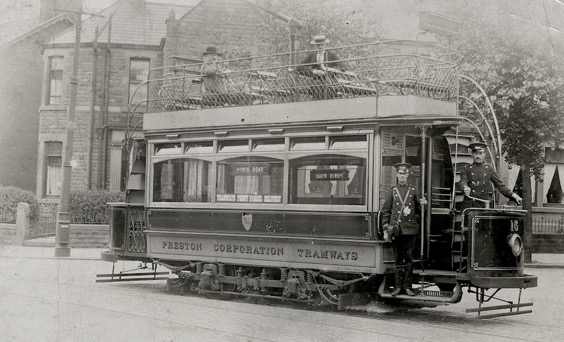
Motorman R Watton at the controls of Tramcar No 15 in Tulketh Road — photo dated 1904. Photo copyright of the Harris Museum and Art Gallery, Preston; courtesy of the Harris Museum and Art Gallery, Preston (see link).
An enlargement of the above photograph showing the conductor and the motorman, both in smart new uniforms with tensioned-crown peaked caps bearing their grades – 'Conductor' and 'Driver'.
General pattern script-lettering grade badges of the type used by Preston Corporation Tramways – brass. Author's Collection.
An inspector, a motorman and a conductor pose with Tramcar No 16 — photo undated, but probably taken in the mid-to-late Edwardian era. Photo copyright of the Harris Museum and Art Gallery, Preston; courtesy of the Harris Museum and Art Gallery, Preston (see link).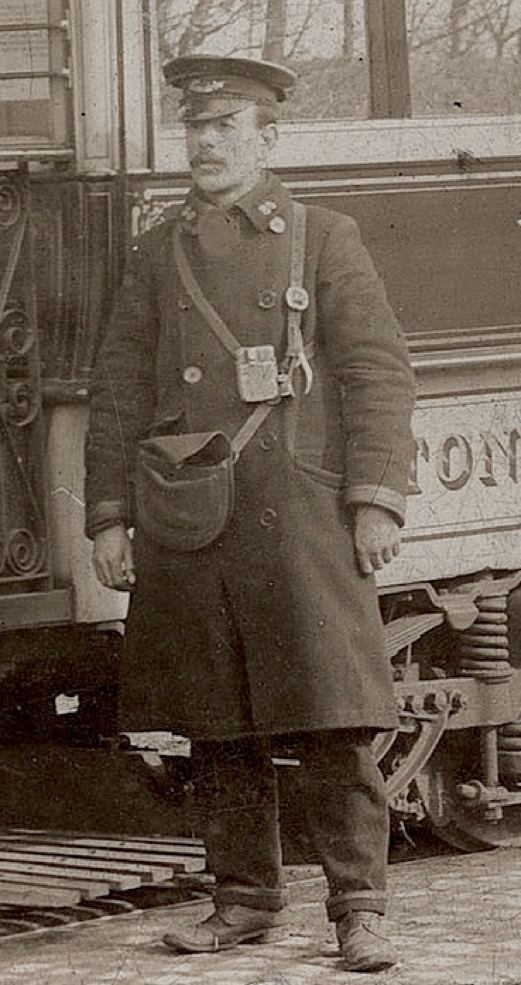
An enlargement of the above photograph showing the conductor (possibly Employee No 89) in his double-breasted greatcoat, which bears non-metal unmarked buttons.
A PCT motorman (employee No 35) — photo undated, but from the moustache, probably Edwardian. Photo courtesy of Graham Willans, via the Preston Digital Archive (see link).
A rather youthful-looking PCT conductor (employee No 119). Whilst his collars clearly display his employee number, the epaulettes would appear to have system initials, 'P C T'. Photo courtesy of Graham Willans, via the Preston Digital Archive (see link).
An excellent studio portrait of another youthful-looking Preston Corporation Tramways conductor, this time of Employee No 76 — photo undated, but possibly late Edwardian or a little later. The photograph was taken in the studios of J. H. Jamieson of 91 Fishergate Preston. Author's Collection.
An enlargement of the above photograph showing details of the cap, collar and epaulette insignia, the latter clearly bearing 'P C T' system initials.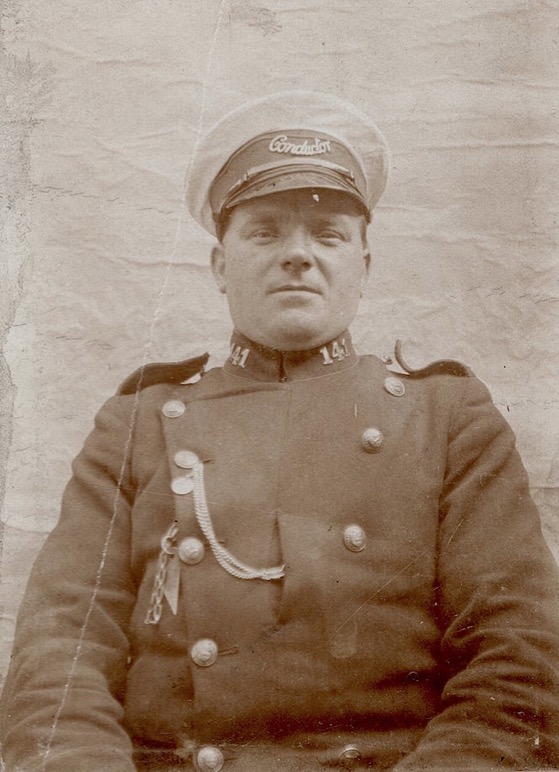
Preston Corporation Tramways conductor (Employee No 141) in his lancer-style tunic — photo undated, but possibly taken in the 1920s. Author's Collection.
A Preston motorman at the controls of Tramcar No 27 with a service bound for the football ground — photo undated, but probably taken in the early 1930s. Photo by M J O'Connor, courtesy of the National Tramway Museum. 
A motorman poses for the cameraman at the controls of Tramcar No 6 at the Ribbleton terminus with a service for Penwortham — photo undated, but probably taken not long before the latter closed in July 1932. Photo courtesy of Preston Digital Archive (see link).
An enlargement of the above photograph, revealing the motorman to be Employee No 24.
A conductor and a driver amongst the throng at Fulwood celebrating the last Preston tram on the 15th December 1935. Photo courtesy of Preston Digital Archive (see link).
Senior staff
An enlargement of the photograph of Tramcar No 16 (mid-to-late Edwardian) showing an Inspector. He is wearing an unmarked overcoat, but clearly has his grade — 'Inspector' — on a hat band on his tensioned-crown peaked cap.
Although of poor quality, this photograph of Preston Corporation Band does show an inspector (seated behind the drum). He is wearing typical tramway inspector garb. Photo by Frederick Constantine Buckley, courtesy of Preston Digital Archive (see link).
Female staff
A group of conductresses (possibly referred to as 'conductorettes' in Preston) pose alongside Tramcar No 39 — photo undated, but almost certainly taken during the Great War or shortly afterwards. Photo courtesy of Preston Digital Archive (see link).